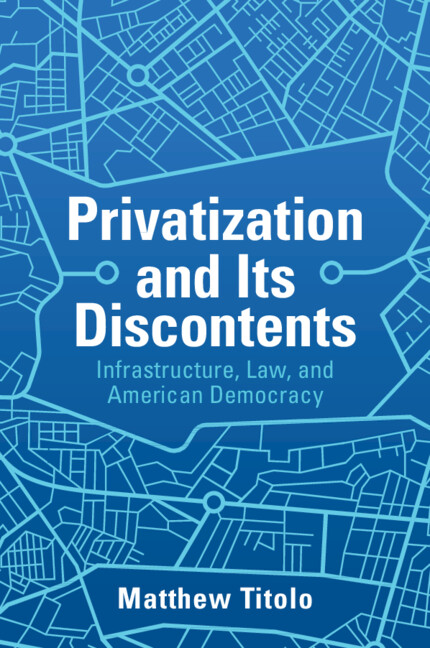
Infrastructure and privatization are enduring topics in modern political discourse. Privatization and Its Discontents: Infrastructure, Law, and American History places these contemporary hot topics in perspective, identifying today’s debates as deeper problems within liberal statecraft that are of long historical vintage. In the American context, infrastructure has been created through models of public-private governance, and this mixed model has resulted in a longstanding battle over the proper role of government and corporations in supplying the infrastructures of the market state in a democratic society. The book’s introduction provides a useful overview of modern scholarship on infrastructure and will be useful for students and scholars alike. It shows that infrastructure is a modern developmental concept that emerges in the nineteenth and twentieth centuries. Infrastructure is an idea that points us to the necessary material precursors to a functioning modern economy: transportation, communication, public utilities, etc. It is also an elastic concept whose definition can change over time. Privatization and Its Discontents shows that infrastructure is an enduring issue within law, politics and the economy in the modern era.
“Early Liberalism, Adam Smith, and the Seeds of the Infrastructural State” begins in the eighteenth century, with Adam Smith’s discussion of infrastructure and public works. Wealth of Nations, for example, far from simply advocating laissez-faire, shows that public works infrastructure supplies the foundation for an emerging capitalism and would need substantial state involvement. Reading Wealth of Nations shows the entanglement of infrastructure, finance, taxation and economic development that have shaped the liberal project from its beginnings. The first chapter shows that the concept of debt-financing was also central to the emergence of public works infrastructure. The question of whether money and government debt should be properly viewed as public or private become important for later attitudes about investment in infrastructure.
“Forging the Infrastructural State 1787–1837” then discusses Alexander Hamilton and the American founding to show how the republic’s beginnings were grounded in developmentalism and not a laissez-faire state. Debates over internal improvements shaped politics in the early republic and throughout the nineteenth century and suggest the deeper tensions within developmental liberalism from the beginning. Internal improvements debates were also debates over the American Constitution, and implicated competing visions of the nation’s founding document. On the one hand, Federalists argued for expansive congressional powers to build infrastructure based on the “necessary and proper” and Postal Clauses of Article I, Section 8. On the other hand, Republicans embraced a strict constructionist perspective that was intended to narrow the scope of federal infrastructural power. Nevertheless, the federal government remained involved in infrastructure projects throughout the nineteenth century.
“’A Wilderness of Turnpike Gates:’ Roads and Public Authority in Antebellum America” uses the case of turnpikes to illustrate the public and private developmentalism of the mid nineteenth century. Turnpikes are an early example of a “public-private partnership.” Chapter three explains that the legal construction of public space within liberalism meant that although turnpikes were private ventures, governments treated them as quasi-public agencies of government. This quasi-public status caused problems for turnpikes as business ventures throughout the nineteenth century. Because the general public was often suspicious of privatization of customary public spaces, legislatures had to proceed with caution before allowing turnpikes to raise rates. Legislatures had to balance public power and private rights, with their thumb placed heavily on the scales in favor of public power and control. This level of public control, as well as other developments, such as competing railroad infrastructure, ultimately frustrated the turnpike business model.
“The Panic of 1837 and the Infrastructure Crash” takes the narrative to state development programs in the 1820s and 30s. States began developing road and canal networks in this period in the absence of the extensive federal investment that they hoped for. States had the advantage that they could charter companies and could condition the charter of banks on their lending money to infrastructure ventures. States could also offer financial and tax incentives as well as granting eminent domain powers to new infrastructure companies. States financed these ventures in a variety of ways, including through “taxless finance,” which could involve selling state bonds and using the money to invest in a canal or railroad. The proceeds from the infrastructure in fees and tolls would then be used to pay back bondholders. Problems emerged in the late 1830s when several states borrowed far more than they could afford. This led to defaults, a financial crisis and a serious contraction in the ability of states to borrow. States began amending their constitutions to place limits on borrowing and subsidizing private ventures for anything other than a “public purpose.” The problem was defining what counted as a public purpose, an issue that was taken up by courts in the following decades.
“‘The Ground under Our Feet’ The Birth of Public Utilities” moves to the late nineteenth century, focusing on the Civil War Amendments and the expansion of infrastructure investment. A series of Supreme Court decisions developed a jurisprudence of private rights called “substantive due process” that seemed to provide an answer to the question of “public purpose” that was raised after the financial crisis in the late 1830s. Courts began to protect property from taxation and ruled that local governments could not freely subsidize private infrastructure ventures as they once had. Nevertheless, the trend for networked infrastructures into the twentieth century would be in regulated public and private monopolies and more federal and state regulation. A generation of Progressive reformers used infrastructure and public utility as the conceptual scaffolding for a new idea of the public interest.
“The Death of Laissez-Faire and the Rise of Infrastructure in the Cold War” explains the emergence of the now-familiar infrastructure concept as a phenomenon of mid-century liberal developmentalism. Legal thinkers and courts moved away from the sharp divisions between public and private that had characterized the late nineteenth century. In particular, legal realism and economics provided a new direction that suggested a managerial frame for the emerging post war order, in which experts would become the custodians of the public good. Infrastructure entered this new managerial frame, becoming an important keyword for liberal economic development and governance. Modernization theory posited infrastructure as a cornerstone for the market state, building on Adam Smith. The World Bank and NATO had already used the term infrastructure to describe military facilities that would benefit from Marshall Plan investment. Congressional debates in the 1950s and 1960s show the term migrating from the narrow context of Marshall Plan investment to become an all-purpose word for development without a fixed definition.
From the 1960s onwards, we can see competing definitions of infrastructure, with liberals preferring a broader definition that encompasses social programs and government aid and a more conservative definition that prefers hard infrastructure development, such as roads, bridges, airports, etc., with the priority given to the private sector. The book’s conclusion shows the reemergence of infrastructure as a political theme in the 1980s, when the Reagan revolution and the new federalism retrenched public spending on infrastructure. Today, infrastructure has again become a rallying cry for developmental liberalism.

Privatization and Its Discontents by Matthew Titolo
Latest Comments
Have your say!